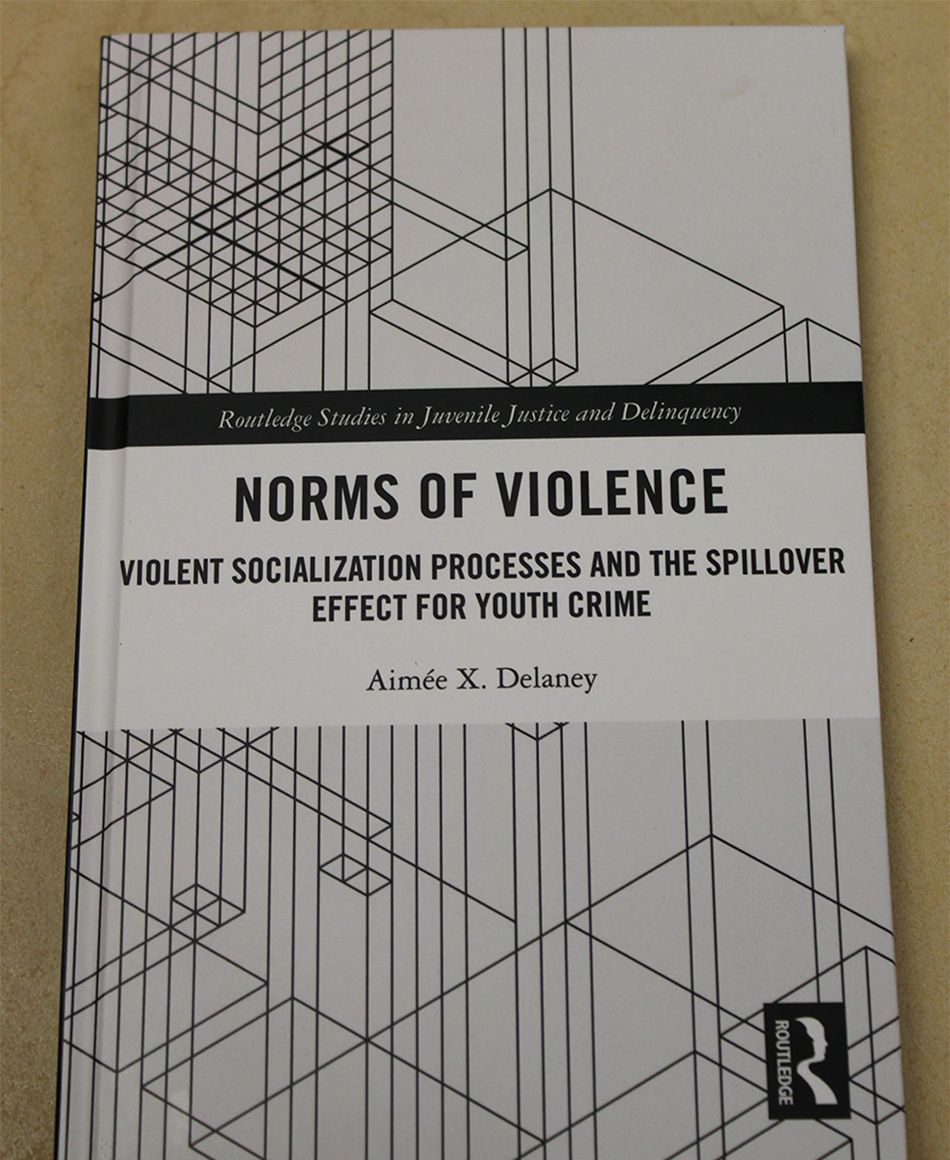What We’re Reading: Norms of Violence
Norms of Violence: Violent Socialization Processes and the Spillover Effect for Youth Crime
By Associate Professor Aimee X. Delaney
Routledge, September 2022
When Aimée X. Delaney was in high school, she knew she wanted to go into law enforcement because she wanted to help people. When she started her first job, though, she found the reality was quite different from what she had imagined. “I realized I’m not actually helping people,” she said. “I’m just enforcing the law.”
A couple of job changes later, Delaney was an investigator for the state of New Hampshire, looking at cases of everything from conflicts of interest among state employees to the victimization of children. Two of the cases Delaney worked on during this time resulted in the saving of two children’s lives.
As rewarding as that was, when she decided to start a family, she stepped away from her role as an investigator and went back to graduate school. There, she tried to pursue a line of inquiry that didn’t involve violence, but her PhD advisor at the University of New Hampshire, Dr. Murray Strauss, asked her, “Why would you throw all that knowledge away?” He encouraged her to expand upon her practical expertise by looking at research into violence.
Now an associate professor in criminal justice and secretary of the Academy of Criminal Justice Sciences, she has put her expertise to good use in her 2022 book, Norms of Violence: Violent Socialization Processes and the Spillover Effect for Youth Crime from Routledge.
 Delaney spent more than six years analyzing data from 17,000 participants across more than 30 countries collected during the years 2001-06. From this data, she developed her theory of norms of violence. “Violence is more than just hitting people,” she said. “Violence can be witnessing it, telling people to engage in violence, raising children where violence is presented as an appropriate form of conflict resolution. It’s more than what we might call the cycle of violence, because it’s not necessarily people repeating it; it’s at the societal level, where we normalize violence in the socialization of children and actually encourage it.”
Delaney spent more than six years analyzing data from 17,000 participants across more than 30 countries collected during the years 2001-06. From this data, she developed her theory of norms of violence. “Violence is more than just hitting people,” she said. “Violence can be witnessing it, telling people to engage in violence, raising children where violence is presented as an appropriate form of conflict resolution. It’s more than what we might call the cycle of violence, because it’s not necessarily people repeating it; it’s at the societal level, where we normalize violence in the socialization of children and actually encourage it.”
The socialization of people to violence is one of the key points of Delaney’s argument. “Just because people engage in illicit behavior doesn’t make them bad. Being an investigator, you learn that,” she said. “Sometimes people who engage in violent acts, it’s not that they’re violent criminals or violent deviants.” Rather, those individuals have absorbed the message that violence is acceptable. That message may have been delivered explicitly, by, for instance, being told by a parent to punch a bully, or implicitly, by, for example, simply living in a country that has the death penalty.
Delaney says she defines violence a bit more broadly than some of her colleagues, and not all the acts that she defines as violent—sexual coercion, for example, or spanking children—are considered crimes. She, therefore, spends some time in her book defining violence and theories of crime.
A good deal of the book is spent looking closely at the data Delaney used to construct her argument and delineating differences in actions and outcomes across nations. Of particular note are the many factors that contribute to the normalization of violence over time.
Delaney acknowledges the challenges in analyzing the data. She used multiple areas that could be measured with validity across nations, but sometimes, she said, there was no explanation she could find for a country’s level of violence. “People can come up with anecdotal explanations,” she said, “but there are no statistical explanations. Colleagues will say things like, ‘What about war?’ Well, how do you define war? How do you measure war? Is it a war or is it a conflict? Is it a terrorist act or is it a war? It’s challenging.”
The book received the 2023 Outstanding Book Award (international section) from the Academy of Criminal Justice Sciences, an international association of criminal justice experts that fosters professional and scholarly activities in the field.
Delaney has not forgotten her goal of helping people. She hopes that her work can help alter societal perceptions on what violence is, with the ultimate goal of reducing violence. She included a chapter on policy regarding child rearing in Norms of Violence, considering how families and communities can be supported in raising children who won’t engage in violent behaviors in a way that keeps in mind cultural traditions and potentially limited resources.
–By Rebecca Cross

